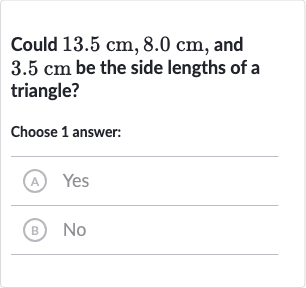Full solution
Q. Could , and be the side lengths of a triangle?Choose answer:(A) Yes(B) No
- Use Triangle Inequality Theorem: To determine if three lengths can form a triangle, we can use the Triangle Inequality Theorem, which states that the sum of the lengths of any two sides of a triangle must be greater than the length of the third side.
- Check Shortest Sides: First, we check if the sum of the two shortest sides is greater than the longest side. The two shortest sides are and , and the longest side is . We calculate and compare it to .
- Calculate Sum: The sum of the two shortest sides is . This sum must be greater than the longest side, which is , to satisfy the Triangle Inequality Theorem.
- Verify Triangle Formation: Since is not greater than , the lengths , , and do not satisfy the Triangle Inequality Theorem and therefore cannot form a triangle.
More problems from Is (x, y) a solution to the system of equations?
QuestionGet tutor help

